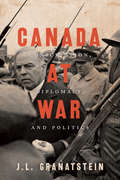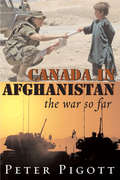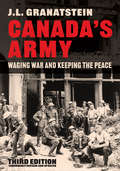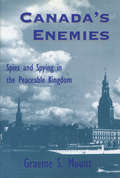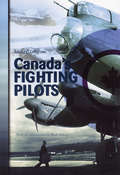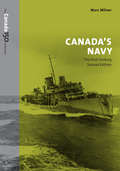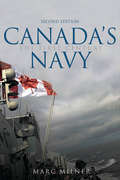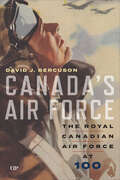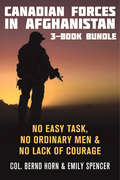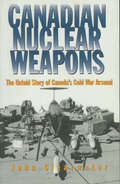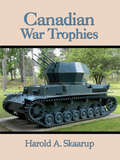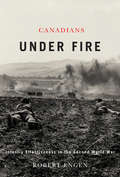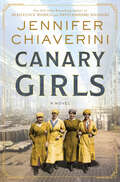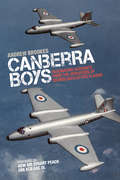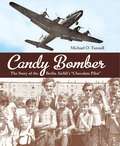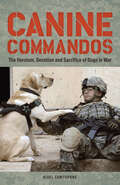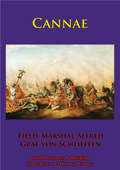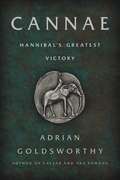- Table View
- List View
Canada at War: Conscription, Diplomacy, and Politics (G - Reference,information And Interdisciplinary Subjects Ser.)
by J.L. GranatsteinWar can subject nations and their peoples to immense strain, and the dangers both tear societies apart and transform attitudes at a great pace. In this collection of his previously published essays on the two world wars, J.L. Granatstein brings together research from archives in Canada and abroad, illuminating Canada’s political transition from the British to American sphere of influence in the first half of the twentieth century. Canada at War examines the impact of both world wars on Canada and Canadians by examining conscription, foreign policy, and politics, with William Lyon Mackenzie King, Canada’s longest-serving prime minister, acting as the book’s central figure. Mackenzie King knew that Canada had barely survived the conscription crisis of the Great War, and he strove to avoid similar political strains in the Second World War. In Canada at War, Granatstein reflects on the most significant issues affecting Canadians during the wars, showing how this period ushered change into the Canadian landscape and transformed Canada into the country that it is today.
Canada between Vichy and Free France, 1940-1945
by Oliver CourteauxThe relationship between Canada and France has always been complicated by the Canadian federal government's relations with Quebec. In this first study of Franco-Canadian relations during the Second World War, Olivier Courteaux demonstrates how Canada's wartime foreign policy was shaped by the country's internal divides.As Courteaux shows, Quebec's vocal nationalist minority came to openly support France's fascist Vichy regime and resented Canada's involvement in a 'British' war, while English Canada was largely sympathetic to de Gaulle's Free French movement and accepted its duty to aid embattled Mother Britain. Meanwhile, on the world stage, Canada deftly juggled ties with both French factions to appease Great Britain and the United States before eventually giving full support to the Free French movement.Courteaux concludes this extensively detailed study by illustrating Canada's vital role in helping France reassert its position on the global stage after 1944. Filled with international intrigue and larger-than-life characters, Canada between Vichy and Free France adds greatly to our comprehension of Canada's foreign relations and political history.
Canada in Afghanistan: The War So Far
by Peter PigottIt has been said that Canada is a country with too much geography and too little history. Afghanistan has too much of both. As the war escalates in Afghanistan, more Canadians are asking what we are doing there. For a country that has specialized in peacekeeping, this war is a shock one that we have not yet comprehended. As the casualties mount, Canadians will want to know why we are there. Canada in Afghanistan introduces readers to Afghans and their culture, gives historical background from our involvement since 9/11, and covers operations casualties and the results. Also included is an examination of a new strategic experiment the provincial reconstruction team and the technological advances used in this war. Cautionary predictions conclude the book. Canada in Afghanistan is an introduction to what is happening in Afghanistan and what we can expect through 2009.
Canada in Sudan: War Without Borders
by Peter PigottAn ancient Arab proverb states, "When Allah made the Sudan, he laughed." Had he known the country’s future, he would have done better to cry. To most of the world, Sudan means Darfur and the tragedy of atrocities and ethnic cleansing that has occurred there. Canada’s first involvement in Sudan was in 1884, when Canadian voyageurs were recruited to help rescue General Gordon, who was besieged in Khartoum by the Mahdi. Canada in Sudan introduces Canadians to this massive, troubled nation, telling the story from ancient times through to the modern era and the work of Canadian archaeologists, aid organizations, and Canadian Forces military observers deployed to Sudan as part of Operation Safari. On March 30, 2007, Minister for Foreign Affairs Peter MacKay said, "Sudan is an almost perfect storm of conflict, dislocation, underdevelopment, and brutality." Perhaps he was confirming that Canada will be in Sudan for a very long time.
Canada in the Great Power Game 1914-2014
by Gwynne DyerCanada in the Great Power Game 1914-2014 is a serious contemplation of what it means to engage in major world conflicts, and the price we pay when we do. The First World War was Canada's baptism of fire, or at least the only one that people now remember. (Montrealers in 1776 or Torontonians in 1814 would have taken a different view.) From 1914 to 1918, after a century of peace, Canadians were plunged back into the old world of great power rivalries and great wars. So was everybody else, but Canadians were volunteers. We didn't have to fight, but we chose to, out of loyalty to ideas and institutions that today many of us no longer believe in. And we have been doing the same thing ever since, although we haven't quite given up on the latest set of ideas and institutions yet.In Canada in the Great Power Game, Gwynne Dyer moves back and forth between the seminal event, the First World War, and all the later conflicts that Canada chose to fight in. He draws parallels between these conflicts, with the same idealism among the young soldiers, and the same deeply conflicted emotions among the survivors, surfacing time and again in every war right down to Afghanistan. And in each case, the same arguments pro and con arise--mostly from people who are a long, safe way from the killing grounds--for every one of those "wars of choice."Echoing throughout the book are the voices of the people who lived through the wars: the veterans, the politicians, the historians, the eyewitnesses. And Dyer takes a number of so-called excursions from his historical account, in which he revisits the events and puts them in context, pausing to ask such questions as "What if we hadn't fought Hitler?" and "Is war written in our genes?" This entertaining and provocative book casts an unsparing eye over what happens when Canada and the great powers get in the war business, illuminating much about how we see ourselves on the world stage.From the Hardcover edition.
Canada's Army: Waging War and Keeping the Peace, Third Edition
by J.L. GranatsteinWritten by J.L. Granatstein, one of the country's leading political and military historians, Canada's Army traces the full three-hundred-year history of the Canadian military. This thoroughly revised third edition brings Granatstein’s work up to date with fresh material and new scholarship on the evolving role of the military in Canadian society. It includes new coverage of the War in Afghanistan; NATO deployments to Poland, Latvia, and Iraq; aid to the civil power deployments; and the role of the army reserve. Masterfully written and passionately argued, Canada's Army offers a rich analysis of the political context for the battles and events that shape our understanding of the Canadian military.
Canada's Enemies: Spies and Spying in the Peaceable Kingdom
by Graeme MountIn 1898, Spanish spies based in Montreal, Halifax, and Victoria monitored the United States war effort against their homeland, while U.S. counter-intelligence officials watched the Spaniards. Neither the Americans nor the Spaniards sought Canadian permission for these activities. Britain’s enemies (and often America’s enemies) have also been Canada’s enemies. Without the heroic counter-intelligence of the mysterious Agent X, Irish Americans at the turn of the century might have blasted British Columbia’s legislature and the Esquimalt naval base the way they blasted the Welland Canal. During World War I, counter-intelligence failed to stop German agents who bombed the Windsor-Walkerville area as well as the CPR bridge on the Maine-New Brunswick border. Meanwhile, Canadian security officials ran around in a state of frantic frustration because of German "conspiracies" along the Ontario-New York State border imagined by Sir Courtney bennett, British consul-general in New york City. After the war, American moles in a Latvian post office monitored mail between Canadian Communists and Moscow. In the thirties, a Finnish-Canadian clergyman spied on Sudbury’s Red Finns for the United States consultate inNorth Bay, and Hitler’s consuls maintained surveillance of Canadian politicians and German dissidents in Canada. During World War II, Canadian authorities intercepted the mail of envoys from Vichy-France, suspected of spying for Germany, and from Franco’s Spain, suspected of spying for Japan. In the 1960s, the CIA not only observed Cubans in Canada, but also watched the situation in Quebec and used a Canadian diplomat to collect information on North Vietnam. Some of this history has merged from previously ignored and newly declassified documents from European, American, and Canadian archives. These newly revealed details show that Canada is an interesting place, both for what Canadians do elsewhere and for what foreigners do in Canada. Also, once readers have seen the kinds of activities in which friends engage, they may be less surprised at what enemies have done.
Canada's Fighting Pilots
by Edmund Cosgrove Brick BillingFirst published in the 1960s and long out of print, Edmund Cosgrove recounts the lives of Canada’s outstanding pilots and their exploits in the two world wars. From the brilliant individualists who flew in the First World War to the tough and dedicated bomber crews of the Second, this is the story of Canadian airmen and their remarkable contribution to the war effort. An essential book for any aviation and history enthusiast, the superbly readable original text that made this book a classic in its day is now supplemented with new and unpublished photos. Gathered together here are the stories of some of Canada’s most celebrated pilots; William "Billy" Bishop, whose daring, solo dawn raid on a German airfield won him the Victoria Cross; William Barker, who fought single-handedly an entire squadron of enemy aircraft; George "Buzz" Beurling, the ace of Malta who achieved a remarkable score of victories fighting from an island under siege; and Andrew Mynarski, whose attempts to save the life of a trapped comrade, high over Germany, ultimately cost him his own. This is their unforgettable story.
Canada's Hundred Days; With The Canadian Corps From Amiens To Mons, Aug. 8-Nov. 11, 1918.: With The Canadian Corps From Amiens To Mons, Aug. 8-nov. 11 1918
by John Frederick Bligh LivesayThe Allied forces on the Western Front had taken a beating under the weight and new tactics of the German army masterminded by General Ludendorff in 1918. However in August the Allies were ready to fight back, and they did so with a vengeance; spearheaded by the Canadian and Australian corps and 500 tanks the allied forces hammered through the German lines. Ludendorff dubbed it as "the Black Day of the German Army". This was the start of the Battle of Amiens and would be the prelude to advances undreamed of by the Allies in earlier years of the war.The Canadian Corps had long established a reputation as a crack formation within the Allied armies and set to their task of rolling up the German lines with a passion. For the next hundred days the allied forces would surge forward and finally force the German forces to final capitulation.As a noted Canadian Author John Livesay set out to record the achievements of his countrymen during the culminating campaign of the First World War. He recounts with élan and excellent detail; the dash and perseverance of the Canadians in forcing the Germans from one position to the next.Author --John Frederick Bligh Livesay 1875-1944.Text taken, whole and complete, from the edition published in Toronto, T. Allen, 1919.Original Page Count - x and 421 pages.
Canada's Navy, 2nd Edition: The First Century
by Marc MilnerFrom its eighteenth-century roots in exploration and trade, to the major conflicts of the First and Second World Wars, through to current roles in multinational operations with United Nations and NATO forces, Canada's navy - now celebrating its one hundredth anniversary - has been an expression of Canadian nationhood and a catalyst in the complex process of national unity.In the second edition of Canada's Navy, Marc Milner brings his classic work up to date and looks back at one hundred years of the Navy in Canada. With supplementary photos, updated sources, a new preface and epilogue, and an additional chapter on the Navy's global reach from 1991 to 2010, this edition carries Canadian Naval history into the twenty-first century. Milner brings effortless prose and exacting attention to detail to his comprehensive and accessible examination of this fascinating Canadian organization. This much-needed update of Canada's Navy will continue to provoke discussion about the past and future of the country's naval forces and their evolving role in the interwoven issues of maritime politics and economics, defence and strategy, and national and foreign policy.
Canada's Navy, 2nd Edition: The First Century
by Marc MilnerFrom its eighteenth-century roots in exploration and trade, to the major conflicts of the First and Second World Wars, through to current roles in multinational operations with United Nations and NATO forces, Canada's navy – now celebrating its one hundredth anniversary – has been an expression of Canadian nationhood and a catalyst in the complex process of national unity. In the second edition of Canada’s Navy, Marc Milner brings his classic work up to date and looks back at one hundred years of the navy in Canada. With supplementary photographs, updated sources, a new preface and epilogue, and an additional chapter on the navy’s global reach from 1991 to 2010, this edition carries Canadian naval history into the twenty-first century. Milner brings effortless prose and exacting detail to discussions about topics as diverse as Arctic sovereignty, fishing wars, and international piracy. Comprehensive and accessible, Canada’s Navy will continue to provoke discussion about the past and future of the country’s naval forces and their evolving role in the interwoven issues of maritime politics and economics, defence and strategy, and national and foreign policy.
Canada’s Air Force: The Royal Canadian Air Force at 100
by David BercusonThe Royal Canadian Air Force (RCAF) was founded in 1924 as a sort of federal air service, carrying out civilian-type operations for Ottawa. In the Second World War, the RCAF grew to more than 200,000 personnel in overseas squadrons and performed virtually every type of mission, including bombing and hunting submarines. Over the decades since, the RCAF has tried valiantly to carry out its mission of defending Canada, even when starved of funds by the federal government. Today, it is once again on the verge of becoming a modern, well-equipped air force. In Canada’s Air Force, historian David J. Bercuson shares the history of the first one hundred years of the Royal Canadian Air Force, from its inception in 1924 to its centennial in 2024. Drawing on memoirs, diaries, unpublished histories, archival sources, interview transcripts, and standard reference works such as The Bomber Command War Diaries, Bercuson traces the history of the RCAF as not only a fighting force but also a human institution. Canada’s Air Force analyses the first century of the RCAF through the clear-eyed perspective of a Canadian historian who has closely scrutinized one hundred years of the RCAF’s story.
Canada’s Intelligence Oversight: Accountability, Transparency, Human Rights, and the Challenge of Foreign Interference (Contributions to Security and Defence Studies)
by Oliver JavanpourHow can intelligence agencies be held accountable without compromising their ability to act quickly and effectively? This book presents how, since 2017, Canada has reshaped its oversight of the CSIS and CSE intelligence services. It describes how the new oversight bodies - the NSIRA, the NSICOP, and the Intelligence Commissioner - work together to review, monitor, and guide intelligence operations. Using open-source reports and data, the book conducts case studies and international comparisons to evaluate whether these reforms have increased transparency and accountability while maintaining operational effectiveness. Addressing professionals, policymakers, and researchers, the book introduces an innovative performance review method tailored to intelligence work. It highlights the gains and growing pains of Canada&’s oversight system and offers five practical reforms to improve it. Written in a clear, evidence-based, and policy-focused style, the book helps readers understand the real-world impact of intelligence oversight and how democratic values and national security can coexist.
Canadian Forces in Afghanistan 3-Book Bundle: No Easy Task / No Ordinary Men / No Lack of Courage
by Colonel Bernd Horn Dr Emily SpencerCanadian Forces, including Special Operations Forces, have played an outsize role in the conflict in Afghanistan, often under a cloak of secrecy. For the first time, Col. Bernd Horn reveals the stories of the troops and operations behind Canada’s pivotal involvement in the Afghanistan conflict. No Ordinary Men Peels back the cloak of secrecy and reveals four untold special operations that Joint Task Force 2, an elite counterterrorist unit, conducted in 2005–06 in which their courage, tenacity, and impressive capabilities meant the difference between life and death. No Lack of Courage The story of the North Atlantic Treaty Organization’s Operation Medusa, the largely Canadian action in Afghanistan from 1 to 17 September 2006, to dislodge a heavily entrenched Taliban force in the Pashmul district of Afghanistans Kandahar Province. No Easy Task Afghanistan has long been considered the graveyard of empires. Those who have ventured into Afghanistan with notions of controlling its people have soon discovered that fighting in that rugged, hostile land is no easy task. This collection of essays examines this legacy of conflict, particularly from a Canadian perspective.
Canadian Nuclear Weapons: The Untold Story of Canada's Cold War Arsenal
by John Clearwater"We are thus not only the first country in the world with the capability to produce nuclear weapons that chose not to do so, we are also the first nuclear armed country to have chosen to divest itself of nuclear weapons."Pierre Trudeau United Nations, 26 May 1978From 1963 to 1984, US nuclear warheads armed Canadian weapons systems in both Canada and West Germany. It is likely that during the early part of this period, the Canadian military was putting more effort, money, and manpower into the nuclear commitment than any other single activity. This important book is an operational-technical history and exposÈ of this period.Its purpose is to bring together until-recently secret information about the nature of the nuclear arsenal in Canada, and combine it with known information about the systems in the US nuclear arsenal. The work begins with an account of the efforts of the Pearson government to sign the agreement with the US necessary to bring nuclear weapons to Canada. Subsequent chapters provide a detailed discussion of the four nuclear weapons systems deployed by Canada: the BOMARC surface-to-air guided interceptor missile; the Honest John short range battlefield rocket; the Starfighter tactical thermonuclear bomber; the VooDoo-Genie air defence system. Each chapter also includes a section on the accidents and incidents which occurred while the weapons were at Canadian sites. The final chapter covers the ultimately futile efforts of the Maritime Air Command and the Royal Canadian Navy to acquire nuclear weapons. An appendix includes the text of the until-now secret agreements Canada signed with the USA for the provision of nuclear weapons.Illustrated throughout with photographs and diagrams, and supported by extensive transcriptions of original documents, Canadian Nuclear Weapons will be of great value both to scholars and interested laypersons in its presentation of what has been a deeply hidden secret of Canadian political and military history.
Canadian War Trophies
by Harold SkaarupWar Prize Weapons & Equipment in Canada from the Crimean War, the Fenian Raids, the Second Boer War, the Great War, the Second World War, the Korean War, the Cold War, the Yugoslav Wars and Afghanistan
Canadians Under Fire
by Robert EngenIn Canadians Under Fire Robert Engen explores the dynamics of what combat looked like to Canada's infantrymen during the Second World War. Analyzing unexamined battle experience questionnaires from over 150 Canadian infantry officers, Engen argues for a reassessment of the tactical behaviour of Canadian soldiers in the Second World War. The evidence also shows that Marshall's theory of non-participation in combat by Allied forces is demonstrably false: Canadian soldiers took a continued and aggressive part in the fighting.
Canadians Under Fire: Infantry Effectiveness in the Second World War
by Robert EngenIn Canadians Under Fire Robert Engen explores the dynamics of what combat looked like to Canada's infantrymen during the Second World War. Analyzing unexamined battle experience questionnaires from over 150 Canadian infantry officers, Engen argues for a reassessment of the tactical behaviour of Canadian soldiers in the Second World War. The evidence also shows that Marshall's theory of non-participation in combat by Allied forces is demonstrably false: Canadian soldiers took a continued and aggressive part in the fighting.
Canaris: The Life and Death of Hitler's Spymaster
by Michael MuellerThis biography of the Nazi intelligence chief who spied both for and against Hitler examines the life of one of WWII&’s most intriguing figures. An early supporter of Adolph Hitler, Wilhelm Canaris became chief of German military intelligence before secretly turning against the Nazi regime at the start of World War II. Throughout his career, few who knew him ever understood his plans. Even today, historians find Wilhelm Canaris a man of mystery among Hitler&’s top lieutenants. The great protector of German opposition to Hitler, Canaris was also the one who prepared the Third Reich&’s major expansion plans. While he motivated those who were eager to bring down Hitler, he also hunted them as conspirators—one of the many contradictions he was forced to live with in order to stay in control of the Nazi spy network. This superbly researched biography follows Canaris's career from his first dabbling in the intelligence business during World War I through his time as head of the Abwehr to his execution in 1945 for his role in the July Plot. A highly readable account, it tells the story of an apparently old-fashioned naval officer, drawn into the web of the Nazi regime.
Canary Girls: A Novel
by Jennifer ChiaveriniRosie the Riveter meets A League of Their Own in New York Times bestselling novelist Jennifer Chiaverini’s lively and illuminating novel about the “munitionettes” who built bombs in Britain’s arsenals during World War I, risking their lives for the war effort and discovering camaraderie and courage on the soccer pitch. Early in the Great War, men left Britain’s factories in droves to enlist. Struggling to keep up production, arsenals hired women to build the weapons the military urgently needed. “Be the Girl Behind the Man Behind the Gun,” the recruitment posters beckoned.Thousands of women—cooks, maids, shopgirls, and housewives—answered their nation’s call. These “munitionettes” worked grueling shifts often seven days a week, handling TNT and other explosives with little protective gear.Among them is nineteen-year-old former housemaid April Tipton. Impressed by her friend Marjorie’s descriptions of higher wages, plentiful meals, and comfortable lodgings, she takes a job at Thornshire Arsenal near London, filling shells in the Danger Building—difficult, dangerous, and absolutely essential work. Joining them is Lucy Dempsey, wife of Daniel Dempsey, Olympic gold medalist and star forward of Tottenham Hotspur. With Daniel away serving in the Footballers’ Battalion, Lucy resolves to do her bit to hasten the end of the war. When her coworkers learn she is a footballer’s wife, they invite her to join the arsenal ladies’ football club, the Thornshire Canaries.The Canaries soon acquire an unexpected fan in the boss’s wife, Helen Purcell, who is deeply troubled by reports that Danger Building workers suffer from serious, unexplained illnesses. One common symptom, the lurid yellow hue of their skin, earns them the nickname “canary girls.” Suspecting a connection between the canary girls’ maladies and the chemicals they handle, Helen joins the arsenal administration as their staunchest, though often unappreciated, advocate. The football pitch is the one place where class distinctions and fears for their men fall away. As the war grinds on and tragedy takes its toll, the Canary Girls persist despite the dangers, proud to serve, determined to outlive the war and rejoice in victory and peace.
Canberra Boys: Fascinating Accounts from the Operators of an English Electric Classic (The\jet Age Ser. #13)
by Andrew BrookesA history of the British bomber aircraft and stories from the crew who served with it. The English Electric Canberra first came into production in the late 1940s and has since played a hugely significant part in world events. In Canberra Boys, Andrew Brookes takes us through its rich history with the help of those who operated this magnificent machine. Contributors include Roly &“Bee&” Beamont, the English Electric test pilot who first flew the aircraft in 1949. As part of the expansion of the RAF&’s Bomber Command in the 1950s, RAF Binbrook was the first station to house four Canberra squadrons, starting with 101 Squadron in May 1951. Since then and throughout the 20th century, the Canberra operated across the globe in Europe, South America, and South East Asia. It has served an array of air forces such as the USAF, Australian air force, and the Indian air force—the third largest operator of the Canberra after the RAF and USAF. This led to the Canberra playing a crucial role as a photo-reconnaissance aircraft in phenomenal operations like the Suez Campaign, the nuclear tests of Operation Grapple and the Indonesian Confrontation. Other tales in the book include participation in the Sassoon Trophy competition, long-distance flights in Exercise Round Trip, and Operation Quick Flight. Concluding with the Canberra PR9&’s final RAF flight on 39 Squadron in July, 2006, this book provides a detailed and fascinating history of an outstanding aircraft alongside illuminating anecdotes from the men who served with this aircraft.
Candy Bomber: The Story of the Berlin Airlift's Chocolate Pilot
by Michael O. TunnellAfter World War II, the United States and Britain airlifted food and supplies into Russian-blockaded West Berlin. US Air Force Lieutenant Gail Halvorsen knew the children of the city were suffering and began dropping candy that floated down to the kids by parachute.
Canine Commandos: The Heroism, Devotion, and Sacrifice of Dogs in War
by Nigel CawthorneMoving accounts of morale-boosting, life-saving dogs in combat—from ancient armored war dogs to the highly-trained canines of today’s modern military.On Stone Age battlefields through both world wars to present-day Afghanistan, dogs have been the loyal companions and trusted compatriots of soldiers worldwide. Now the exciting, heartwarming and heroic stories of history’s most famous combat dogs are compiled in this incredible collection.CAIRO, SEAL Team Six’s Belgian Malinois, who was choppered in with his top-secret unit on their heroic mission to take out Osama bin Laden.RAGS, a Highland terrier who dodged German shell-fire, shrapnel and poison gas to deliver crucial messages to the Western Front.GANDER, the Canadian Royal Rifles’ Newfoundland, who sacrificed his life by scooping up a grenade and carrying it in his mouth away from his unit.EBONY, the fearless German shepherd who alerted soldiers to an imminent ambush, saving 25 men from sudden death in Vietnam’s unyielding jungle.COOPER, the bomb-sniffing Labrador who relentlessly scoured Iraq for explosives until the fateful day when an IED killed him and his handler.
Cannae [Illustrated Edition]
by Field-Marshal Alfred Graf Von SchlieffenOver 100 maps and diagrams are included.As one of the foremost of a new generation of officers around the time of Prussian expansionism and the birth of a federal Germany, he was to experience much warfare first-hand. After graduating with honours from the famed Prussian Kriegsakadamie he was appointed to the planning unit of the German General Staff. He was to see the plans that he worked upon come to bloody but successful conclusions during the wars with Austria in 1866 and most famously the annihilation of French army during the Franco-Prussian War of 1870. Schlieffen's lasting impression on the world was his famous "Schlieffen Plan" which he designed to enable the German army to knock France out of a two front war by a huge flanking manoeuvre through the Low Countries.He studied military history extensively leading to his most famous work was "Cannae", intended to explain and illustrate the driving idea of the battle of encirclement that had achieved so much success throughout history. Using examples from the wars of Hannibal, Frederick the Great, Napoleon and the recent German led wars with Austria and France, he sets out how the encirclement and destruction of an enemy's army should be achieved.The book was seen as a watershed in military theory and was widely read across the world; to ensure that the ideas were disseminated to their students the American Army translated it into English. The effect of Schlieffen's thinking was still felt by the senior officers that fought in the Second World War who were imbued with the principles of Cannae which would be so well defined as part of the German Blitzkrieg. No less a military leader but General Erich Ludendorff, the principal German strategist of the First World War, declared that Schlieffen was "one of the greatest soldiers ever." no mean testament to the man and his principal book.
Cannae: Hannibal's Greatest Victory
by Adrian GoldsworthyFrom an award-winning historian of ancient Rome, the definitive history of Rome's most devastating defeatAugust 2, 216 BC was one of history's bloodiest single days of fighting. On a narrow plain near the Southern Italian town of Cannae, despite outnumbering their opponents almost two to one, a massive Roman army was crushed by the heterogeneous forces of Hannibal, the Carthaginian general who had spectacularly crossed the Alps into Italy two years earlier. The scale of the losses at Cannae--50,000 Roman men killed--was unrivaled until the industrialized slaughter of the First World War. Although the Romans eventually recovered and Carthage lost the war, the Battle of Cannae became Romans' point of reference for all later military catastrophes. Ever since, military commanders confronting a superior force have attempted, and usually failed, to reproduce Hannibal's tactics and their overwhelming success.In Cannae, the celebrated historian Adrian Goldsworthy offers a concise and enthralling history of one of the most famous battles ever waged, setting Cannae within the larger contexts of the Second Punic War and the nature of warfare in the third century BC. It is a gripping read for historians, strategists, and anyone curious about warfare in antiquity and Rome's rise to power.
